Reply To:
Name - Reply Comment
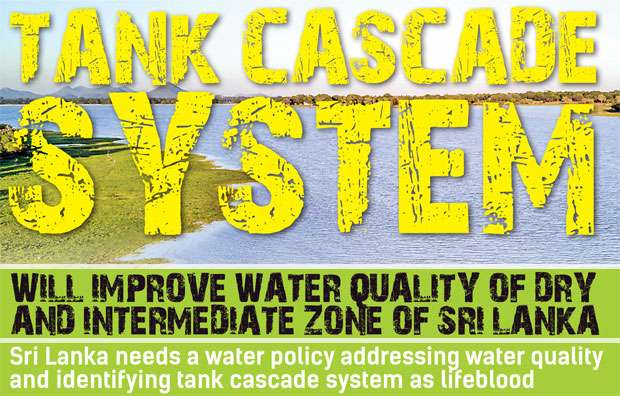
According to world history, many civilizations such as Indus, Mexican, Maya and Inca were originated with the association of rivers and had a long history and flourished with power and knowledge and faded away with the passing time.
Civilization in Sri Lanka is also associated with a Malwathu Oya river, but our civilization is referred to as hydraulic civilization mainly because of the tank cascade system and also the manmade incredible hydraulic structures present over the dry and intermediate zone of the country.
Therefore our civilization did not vanish though it had risen and fallen during the past.
 However, at present, an appreciable percentage of people in the dry zone of Sri Lanka- earlier known as Rajarata and Ruhunurata where hydraulic civilization that thrived- is suffering from Chronic Kidney Disease of unknown aetiology (CKDu).
However, at present, an appreciable percentage of people in the dry zone of Sri Lanka- earlier known as Rajarata and Ruhunurata where hydraulic civilization that thrived- is suffering from Chronic Kidney Disease of unknown aetiology (CKDu).
Analyzing its widespread geographical distribution and histopathological evidence, CKDu is considered a problem related to the environment.
We observed that many hypotheses have been proposed as causative factors for CKDu and established at present as a multifactorial origin. However, these associated factors are related to water. We believe that this occurrence is due to the drastic changes that happened to the hydraulic system of the dry and intermediate zone of the country.
"Most of the people affected by CKDu are from the dry zone"
There is a growing concern over the high incidence of CKDu in the dry and intermediate zone of Sri Lanka, and the ancient tank cascade system with its ecological functions has a potential for controlling this disease.
This article discusses the components of the tank cascade system in improving the water quality of the area.
Figure 01 shows the divisional secretariat level distribution of CKDu patients in Sri Lanka, while figure 02 exhibits the distribution of small tanks in Sri Lanka.
We noted that the CKDu patient spatial distribution is approximately similar to those of tank spatial distribution.
There are no reports indicating that the CKDu prevailed and significant death tall occurred during history in these regions.
According to history, people in the area used to get potable water from the tanks. Therefore we argue that the adverse changes that took place to the ecosystem of the tank cascade system and new commercial practices of agriculture of dry and intermediate zone of the country have also become reasons for the spreading of CKDu.
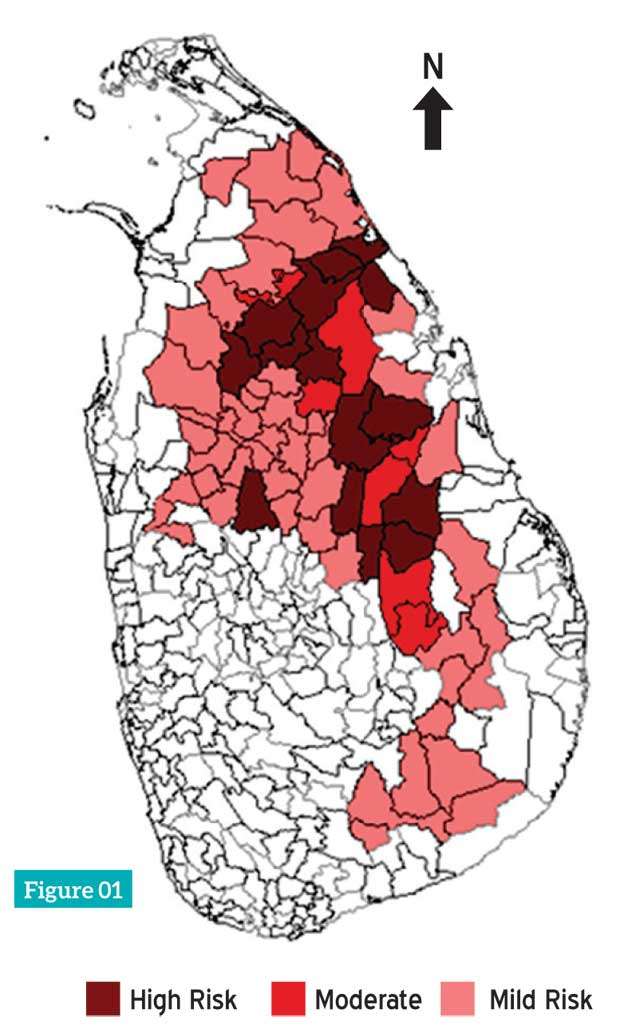
In order to overcome the limited water availability during May to September period, the ancient Sinhalese developed their own water management system now known as the Tank Cascade System.
“A tank cascade is a connected series of tanks organized within a meso-catchment of the dry zone landscape, storing, conveying and utilizing water from an ephemeral rivulet” (Madduma Bandara, 1985).
“This system has been recognized as a Globally Important Agricultural Heritage Systems” (GIAHS) by the FAO in 2018.
The watershed boundary of the meso-catchment, the individual micro-catchment boundaries of the small tanks, the main central valley, side valleys, and axis of the main valley, component small tanks, and the irrigated rice lands are the main elements of a cascade.
Fig 04. Indicates the components of a village tank and their relative positions in the small tank village in Sri Lanka (adapted from Tennakoon, 2015)
Wewa is the main element of tank cascade system and Wewa refers to an artificial lake for storing water on the surface of the ground, which has been constructed by local people at a geographically suitable location using their indigenous skills mostly during ancient times.
Ancient people used to get drinking water from a separate place called Diyamankada of the tank where they planted Kumbuk trees. Kumbuk tree is believed to purify and cool the water, and believed to have an ability to reclaim saline and alkali soils and reduce soil erosion on banks.
Even when the water quantity is less in the tank, villagers were used to getting the water to a clay pot, filtered using a piece of cloth and add Ingini seeds to purify the water.
According to studies, Ingini seeds have the capability of settling down the clay and other suspended matter in the water and softening it. However, after the introduction of groundwater wells to the dry zone in the 1950s, people used groundwater as a source of drinking water.
"CKDu is considered a problem related to the environment"
Components of Wewa and their roles in managing the water pollutants
Wewa consists of some bio-engineering structures in order to conserve the soil, control water flow and purifying water. Schematic representation of components of the small tank is shown in figure 04. Proper functioning of these components, the earthen dam (We-kanda), sluice gates (Sorrowwa), spillways (Pita Wana), valve pit (BissoKotuwa), iswetiya (upstream conservation bund), gasgommana (upstream wind barrier made of tree plantations), kattakaduwa (downstream wind barrier, located in between the sluice and paddy), tisbamme (land strip around the hamlet for protection), thaulla (upper peripheral gentle sloping land) and wew ismaththa (closer catchment) ensure the better quality, quantity and sustainability of the water for the wewa. At present, all these components may not be present in all small tanks in a cascade system.
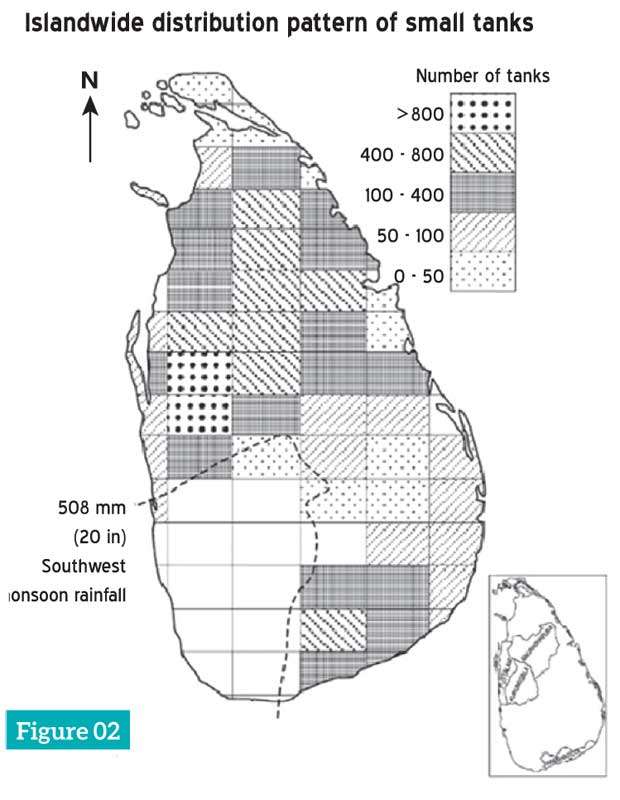
There was essentially an upstream land area dedicated to the tank from which water drained to the tank (closer catchment) through Wew thaulla. The extent of this area depended on the water area of the tank and this area was maintained as a forest in the past.
At present, the closer catchment is very rarely observed in small tanks. Kuluwewa, Godawala and ephemeral streams are generally located in Wew Ismaththa (Fig.04). Wew Ismaththa is protected and cutting trees and chena cultivation is prohibited. The purpose of the area was to increase the groundwater table through infiltration and thereby gradual release of water to the tank during the dry season is expected. Farmers under the headmen of the village were used to grow trees in these areas such as Weera, Kumbuk, Palu, Mee, Thibiri, etc. and establish vines such as Kobbawel, Eraminiya and Thiththawel thinking that these would absorb more water during the rainy season and drain those absorbed water to the tank slowly. A resulting biotic environment is an ideal place for diverse macro and microfauna.
These micro and macro-organisms purify water reaching from upstream tank command areas in this system. Scientists have proved that plants in the biotic-environment can absorb herbicide molecules sorbed onto organic matter and soil microorganisms can degrade the herbicide molecules. Scientific studies showed that some herbicides like glyphosate showed not to leach at all and remain tightly sorbed onto organic complexes. Tree roots and enhanced level of soil organic matter from tree litter improve the soil structure, aggregate stability and promote faunal activity leading to higher macroporosity so that infiltrated water passes through the soil matrix. Generally, pollutants are adsorbed to the clay and sediment particle. This environment in the Wew Ismaththa filters sediments and also pollutants adsorbed to the sediment particle may not then reach to the tank water. Thus, closer catchment had a higher potential to clean the drainage water reaching from the upstream command area where paddy and other field crops grown.
If this area is re-established and conserved as in the early days, there is still a potential to improve the tank water quality even though the upstream area is heavily cultivated with recommended doses of agrochemicals following integrated pest and nutrient management techniques.
The area just below Wew Ismaththa and in between Wew Ismaththa and water spread area of the tank is Wew thaulla. This micro-land region is partly covered with water but only completely flooded during the rainy season. As shown in figure 04, the area where Gasgommana and Perahana are located can be considered as thaulla. Thaulla doesn’t allow water flow of the upstream area/ upper catchment to directly reaching it as a storm.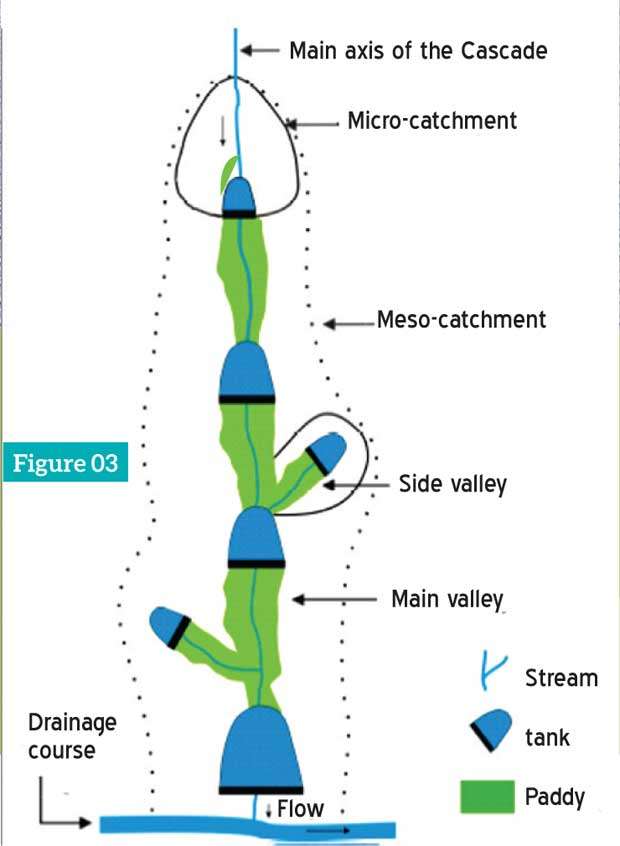
Because it consists of arrays of bushes such as kooratiya, Tharanga, Maila, Pila , etc, and the trees such as Nabada, Dunuke, Mee, etc. In addition sedges such as Hambupan, Thunhiriya, Gal ehi, etc. and also different kind of climbers such as Kaila, Katukeliya, Bokalawel (IUCN 2015)and grasses abound in these land mass. These florae have an ability to trap sediments and absorb pollutants and negate their toxicity reaching to the tank. Moreover, these strip of trees (Gasgommana) act as a wind barrier and also lower the temperature of the water in the tank.
We in the Department of Agric. Engineering and Soil Science of the Rajarata University have shown the nutrient and some metal retention capabilities of thaulla. We also conducted a research at Ulankulama tank at Maradankadawala.
This study found a higher accumulation of Fe (1819.65 ppm) and Al (1586.75 ppm) with a considerable retention of P (74.80 ppm), Ca (163.79 ppm) and Mg (203.67 ppm) in the tested soil.
"Established at present as a multifactorial origin"
Another study done in the same thaulla showed the phytoextraction behaviour of two monocot plants. These results suggest that thaulla, can act approximately as an active ‘constructed wetland’ which efficiently removes pollutants in order to sustain the system.
Scientists have shown the water quality improvement ability of constructed wetland. Since thaulla is submerged with water for about 3 to 5 month during the rainy season, and then drying steadily during the other months, the thaulla and tank water spread area its ecosystem can also be considered as a special wetland.
It has been shown that many species of plants/ trees absorb contaminants such as lead, cadmium, chromium, arsenic, and various radionuclides from soils.
Contaminants in water are reduced or removed by wetland systems by mechanisms including sedimentation, filtration, chemical precipitation and adsorption, microbial interactions and uptake by vegetation.
Ancient people knew that the lifespan of the tank depended on the functions of thaulla.Therefore, entering into this area was customarily prohibited to anybody except the Ayurveda doctor.
However, at present, it is rather difficult to find out the good extent of thaulla in most of the tanks and also conservation of this area is neglected due to overexploitation of the resources and ignorance. This degradation of thaulla area results in lowering the water holding capacity of the tank and impair the water quality.
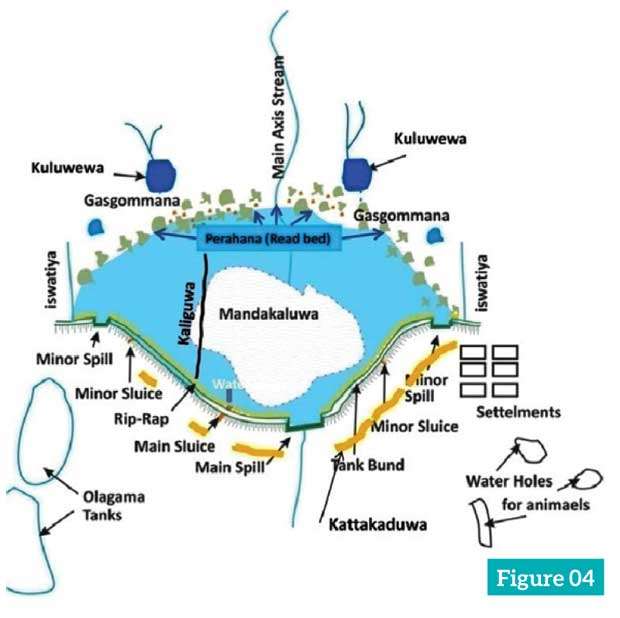
This is an elongated murky meadow with turbid water in between the outer toe of a tank bund and paddy field. When halophytes such as mee, kumbuk, lunuwarana, thimbiri, val beli, and vetakeyya are grown in over the rim of the meadow salts on the water is reduced (Tennakoon, 2015).
Scientist have observed the higher electrical conductivity in this area. This observed higher salinity concentration is due to seepage of water from a dead storage area of the tanks where there is a buildup of salinity in most of the tanks. However, this Kattakaduwa area also acts as a downstream wind barrier and helps to protect soil from erosion as the majority of species consists of well-developed root systems. Hence this ecofriendly structure, Kattakaduwa improves the water quality of the command area by removing excess salts, nutrients and sediments.
This command area is the catchment for the next downstream tank in the tank cascade system.
Iswetiya or Potawetiya is an upstream soil ridge made on either side of the tank bund to avoid sediment particles entering from upper land slopes towards the tank.
In addition, Godawala and Kuluwewa were constructed to trap sediments reaching from the ephemeral stream to the tank. Godawala which is found in association with a small tank, is a manmade waterhole.
Whereas Kuluwewa a small tank/pond above large reservoirs trap sediments and provide water for cattle and wild animals which may be a strategy to avoid man-animal conflicts.Construction of these Iswetiya or Potawetiya, Godawala or Kuluwewa ensures the good water quality and combat siltation of the tank.
In addition, during the dry spells with the frequency of 3 to 5 seasons, villages were used to identify the more silted places of the tank bed and arrange shramadana campaign to remove muds (Kattikapeema).
Moreover, the place of the spillway of the tank is generally designed to open to a low rounded rock outcrop area so that erosion is minimized from the spilt water. Hence, the tank water was sustainably used for drinking, bathing, washing and irrigation. Raising the dam or spill was not required as at present to accommodate a sufficient quantity of water for irrigation.
"People in the area used to get potable water from the tanks. …adverse changes that took place to the ecosystem of the tank cascade system and new commercial practices of agriculture have also become reasons…"
In the command area of the tank where paddy was grown, the old natural stream was used as a common drainage line. It was called as Kiul ela and it could remove salt and iron from polluted water and improved the drainage condition of the paddy fields (Dharmasena, 2004).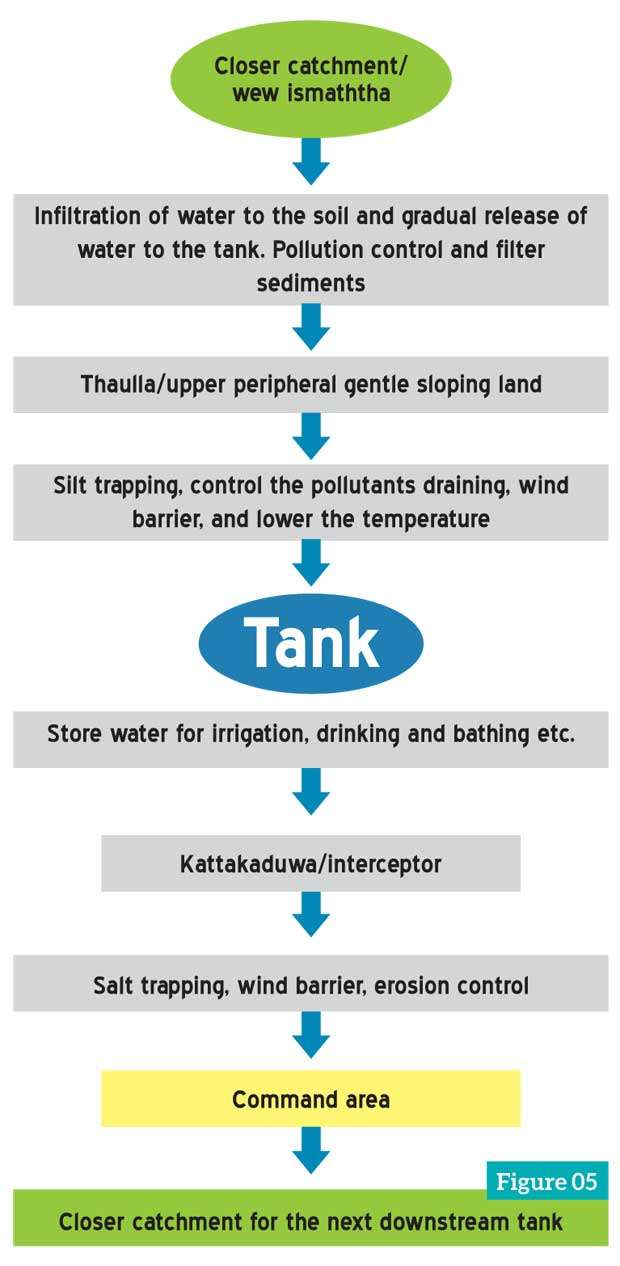
Because, along with the drainage line (Kiulela), there are tree species such as karanda, mee, mat grass, etc. Those trees are capable of trapping excess nutrients and salts and this shows that the drainage water is purified to a considerable extent even at the command area.
This drainage water subsequently reaches to the next downstream tank through the Wew Ismaththa (closer catchment) and Wew thaulla in the cascade system. Dharma-wardana (2015, 2017) stated that the origin of kidney disease was linked to water of high ionicity damaging the membranes in the tubules and other components of the kidney via the Hofmeister mechanism. Ionicity of water substantially is low in tank water when the water passes through these Kattakaduwa – Kiwul Ela system. At present, these systems are neglected in some of the tanks that may result in increased salinity.
Fig 05 : Schematic representation of the profile of a small tank and its components ( Produce by the Authors)
The benefit of tank cascade system is that the downstream tank captures the excess water from the tank above. Thus water is not wasted but recycled.
However, this age-old concept has not been continued during the 1950s to 1970s where short-sighted efforts have been increasingly made by the water resource managers.
If all these tanks were in operation (around 15,000), we hope there is no need of excavating groundwater for drinking or even farming.
Use of groundwater for drinking has been one of the causes of CKDu because of its higher ionicity. We hope still there is a possibility to adapt to these tank cascade system and integrate the ancient technology with the novel watershed management techniques so that we could supply quality drinking water to dry and intermediate zone of the country.
Sri Lanka needs a water policy formulation addressing the water quality issues and identifying the tank cascade system as the lifeblood of the dry zone rather than water of trans-basin water diversion system such as the Mahaweli system.
Components of the tanks need to be well delineated and recognized as vital areas in improving the water quality.
The writer is a Senior Lecturer at the Department of Agric. Engineering and Soil Science, Faculty of Agriculture,Rajarata University.